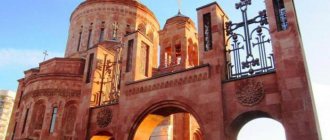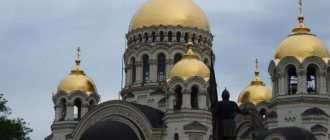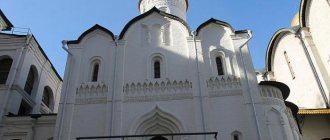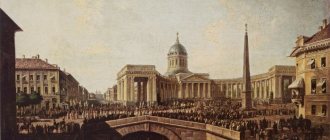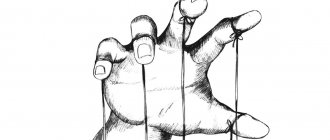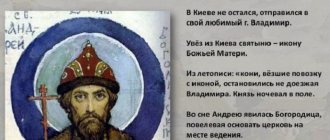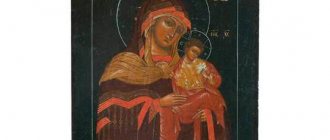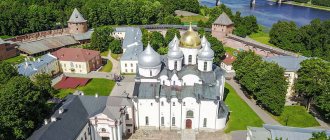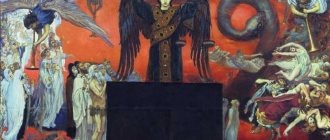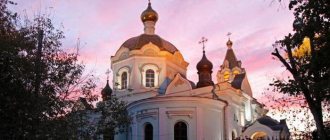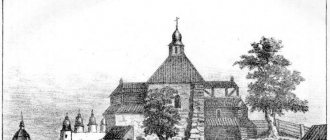| Panorama of Bethlehem. View of the historical city center |
Bethlehem
(Hebrew בית לחם, Beit Lehem - “House of Bread”; Arabic. بيت لحم, Beit Lakhm - “House of Meat”) is the place of the Nativity of Christ according to the flesh, a city, the administrative center of the Bethlehem province of the Palestinian Authority, in within the Jerusalem Orthodox Church.
Located in the Judean Highlands, in the western part of the watershed ridge, between the fertile area of the city of Beit Jala and the arid Field of Boaz and the Field of the Shepherds (Beit Sahur), 9 km southwest of Jerusalem. For the city of the same name in Galilee, see Bethlehem of Galilee
- On the map: Yandex.Map, Google map
The name of the settlement, in Hebrew Beth-Lechem
(“House of Bread”), Hellenized as
Bethlehem
(Βηθλεέμ) - symbolically indicates the Bread of Life - Jesus Christ (John 6:48). Perhaps it also suggests that in ancient times the cultivation of grain crops was quite developed in the vicinity of Bethlehem. Since prehistoric times, Bethlehem has been inhabited from time to time. Archaeological surveys in the area have uncovered a number of cisterns, some built in a manner typical of the Bronze Age; the remains of a settlement and an Iron Age tomb (10th century BC) were discovered.
Despite its fairly frequent mention in the Bible, the city did not play a significant role in the political history of Ancient Israel. In the book of Genesis the city also appears under the name Ephrath.
, near which Rachel died and was buried (Gen. 35:19).
Bit-Lahmu
named in the Amarna letters of the 14th century BC, is none other than Bethlehem [1]. In the list of regions of Judea at the time of Joshua (Joshua 15, 21-22), Bethlehem is named the main city of the 10th region. It was the local center of the possessions of the clan of Ephrath (1 Kings 17:12; Ruth 1:2; cf.: Micah 5:2, Ruth 4:11). This is also where the book of Ruth takes place. Thus, Bethlehem became the “house of David” - his great-grandfathers Boaz and Ruth, his father Jesse lived here, Hazael, a nephew and one of David’s supporters, came from here (1 Chron 2, 16; 1 Sam 23, 24; 1 Chron 11, 26; 2 Kings 2:32). Bethlehem was the place of election and anointing of David to the kingdom by the prophet Samuel (1 Samuel 16, 1-13; 17, 12; 20, 6; 2 Samuel 23, 14-16).
Already in David’s youth, the city was surrounded by a wall (cf. the mention of the city gates in 2 Samuel 23, 15, 1 Chron 11, 17-18) [2]. King Rehoboam turned it into a fortress, the northeastern bastion of a defensive system that guarded the central region of Judea (2 Chron. 11, 6). Only 123 people returned from the Babylonian captivity to Bethlehem (1 Ezra 2:21, cf. Neh. 7:26), which makes Bethlehem a small city (cf. Micah 5:1). However, as can be seen from the prophecy of Micah (Micah 5: 1-3), the memory of the fact that King David came from Bethlehem never disappeared among the Israeli people. People remembered his humble origins, when the glory of the descendants of the founder of the royal dynasty had already faded, and hoped that history would repeat itself: a New David would be born into a modest family in Bethlehem. In accordance with this prophecy (cf. Mt 2:6), the Lord Jesus Christ was born in Bethlehem according to the flesh (Mt 2:2-18; Lk 2:1-20; cf. Jn 7:42). Immediately after this, the city became the site of the first mass martyrdom for Christ - the massacre of the Bethlehem infants.
After the revolt in 135, Bethlehem was occupied by a Roman garrison, as evidenced by a Roman inscription next to Rachel's tomb. With the advent of the Christian era, Bethlehem is constantly mentioned and described by Christian pilgrims who came to worship the place of the birth of the Savior. A Christian consecrated building also appeared - Emperor Hadrian destroyed it and built a pagan temple of Tammuz (Adonis) there [3]. The Holy Equal-to-the-Apostles Kings Constantine and Helena in the 330s erected the majestic Basilica of the Nativity of Christ on the holy site, which since that time has been the center of worldwide Christian worship, second in importance after the Jerusalem Church of the Resurrection over Calvary and the Holy Sepulcher. As part of the Christian Eastern Roman Empire, the city flourished as a pilgrimage center; in addition to the Cave and the Church of the Nativity, the Milk Cave began to be revered here, where, according to legend, the Holy Family also stayed. Not later than a century ago, a Christian monastery appeared here. For at least a century, in addition to the Orthodox, anti-Chalcedonian Armenians were present in the city. In 529, the city was destroyed at the hands of rebel Samaritans, but was immediately restored by Emperor Justinian.
Since the 7th century, Bethlehem has shared the fate of the Holy Land, being successively occupied by various conquerors. In 619-629, the Persians dominated here; in the 630s, the city was captured by Muslim Arabs. In June 1099, Bethlehem took Tancred with a detachment of 100 crusader horsemen. The Roman Catholic Crusaders were the first to establish a special diocese of Bethlehem here. The Crusaders occupied the city until September 15, 1187, when the army of Salah ad-Din occupied it. In 1229, according to an agreement between Frederick II and al-Malik al-Kamil, the city passed to the latter, and was finally recaptured by Turkic troops in 1244, then becoming part of Mamluk Egypt.
| Pilgrims in Bethlehem at Christmas. Photo from 1890 |
In the descriptions of pilgrims from the 14th century, in addition to Orthodox Arabs and Greeks, Roman Catholic Latins and anti-Chalcedonian Armenians, Orthodox Georgians, Roman Catholic Maronites, anti-Chalcedonites of the Ethiopian and Syrian churches, anti-Ephesites, and others are mentioned. By the time of the occupation of Palestine by the Ottomans in the century, Bethlehem had fallen into complete decline, from which it only recovered from the beginning of the 19th century. No later than 1634, the Orthodox diocese of Bethlehem was known. By the end of the 19th century, the city bore the Arabic name Beit Lakhm
(“House of Meat”), was surrounded by vineyards and well-cultivated grain fields, and the inhabitants, almost exclusively Christians, in addition to farming and gardening, were engaged in the manufacture of commemorative crosses, rosaries, and medallions. On November 15, 1900, the Russian Imperial Palestine Society opened a primary school for Arab Orthodox children in Bethlehem, which existed until the outbreak of the First World War.
Since the beginning of the century, extensive archaeological excavations have been carried out in Bethlehem for about a century, which have made it possible to significantly expand the understanding of the history of the city.
Religious statistics
- con. XIX-early V. [4] - 6 thousand. Arab inhabitants, half Orthodox, half Roman Catholic; There are no more than 200 Muslims.
Period of Israel and Judah
Irrefutable archaeological evidence that the land where the city of Bethlehem is located was controlled by Judah in biblical times was discovered in 2012 during excavations in the center of Jerusalem. Then a bull was discovered on which it was reported that grain had been delivered to the king from Bethlehem.
Very often in scientific literature Bethlehem is identified with the biblical Ephrath, the name of which means “fertile.” This identification is justified, since the city is indeed located in fertile lands. In addition, the Bible says that it was in Bethlehem that Rachel was buried, whose grave, according to legend, is located at the city gates. It is also assumed that it was in this city that David was anointed as king by the prophet Samuel.
According to unconfirmed information, indicated in the Bordeaux Itinerary by an unknown Christian pilgrim, in Bethlehem there are the graves of Ezekiel, Isaiah, Asaph, Job and even Solomon.
Christian enclave
The city of Bethlehem is where Muslims and Christians live peacefully. Until recently (50 years ago), the city was almost entirely Orthodox, but now the number of believers of Christian denominations has decreased.
The main place of the Orthodox world - the Church of the Nativity of Christ has a vast territory. Three monasteries are directly adjacent to the shrine: Orthodox, Armenian and Franciscan. The temple is owned by three confessions; only Orthodox priests have the right to conduct services at the main altar.
The heart of the temple is under the altar. You need to go down to it along an ancient staircase, having reached the grotto, you can see a silver star in the floor, meaning the place where Christ was born. This is the main purpose of pilgrimage for Christians around the world. For the opportunity to touch the shrine, believers travel long distances.
The temple itself is wonderful. Built many centuries ago from rough stone, it preserves ancient architecture and is more like a fortress, always ready to defend and protect its pilgrims and servants. Recent restoration work allows us to see in some places a mosaic floor made during the reign of Emperor Justinian. Remains of mosaic decoration are visible on the walls, and there is also painting there. The painted images of the Saints amaze the imagination and enhance the feelings of believers visiting the temple. The sixteen columns supporting the vault date from the fifteenth century and belong to the Crusader period. They are decorated with paintings, but they are difficult to see.
Urban infrastructure and environment
According to international organizations, more than 84% of Bethlehem residents over ten years of age can read and write, and more than ten percent receive diplomas. The city's first higher educational institution was Bethlehem University, opened in 1893 by the de La Salle brothers, who made a huge contribution to the development of educational infrastructure not only in Palestine but also in Egypt.
With such a small population, it is not surprising that the city does not have its own airport, but there are three bus stations, two taxi stations, for this reason getting to it from other cities of Palestine or Israel is not difficult. However, Israeli citizens are prohibited from visiting Bethlehem, as relations between the two states are very tense.
Transport
Public transport in Bethlehem is poorly developed. Most of the roads are run by old buses and minibuses without air conditioning, and the drivers do not follow the schedule, so you can wait for a very long time. Tickets can be purchased from the driver at the entrance.
It is much more comfortable to travel by taxi: cars are parked on the Palestinian side immediately after the checkpoint. But they do not operate on a meter and do not have a fixed tariff.
Taxi drivers strive to earn as much as possible from foreign tourists. Bidding starts with large sums, and prices are often quoted in euros. But drivers quickly make concessions, and a trip from the city border to its center ends up costing 20 ILS.
You can catch a car simply on the streets. Since Bethlehem is a popular tourist destination, taxis are not a problem here. But it is impossible to rent a vehicle or a bicycle - this service is completely undeveloped in a small Arab city. But the key attractions are conveniently located and close to each other, so they can be easily explored on foot.
origin of name
Although most people know Bethlehem from the New Testament, where it is mentioned in connection with the birth of Christ, its history is much more ancient and is associated with the life of the Canaanites, that is, the inhabitants of the western part of the Fertile Crescent.
In these lands, overlooking the Mediterranean Sea, in 1400 BC there were cities controlled by Egypt, ruled by the Canaanites. Presumably the very name of the city, which translates as “house of bread,” is related to the Akkadian heritage and indicates that in this small village at that time there was a sanctuary dedicated to the god of fertility.
Most scholars who have studied the history of this city and the entire country where Bethlehem is located agree that for almost three and a half thousand years the name remained unchanged, although it meant different things. For example, in Canaanite it meant “House of the god Lahmu,” in Akkadian it meant “House of Bread,” and in Arabic it meant “house where there is meat.”
After the creation of Israel
When answering the question of where and in what country Bethlehem is located, one cannot avoid the question of the first years of the existence of the Israeli state, when during the Arab-Israeli war Bethlehem came under the control of Jordan. It was this fact that ensured its subsequent entry into the Palestinian Authority.
However, already in 1967, the Six Day War broke out, during which Israel captured not only the city, which at that time already had an Arab majority, but also the entire West Bank. However, in 1995, under strong international pressure, Israel handed over control of the city to the Palestinian authorities. Thus, when asked where Bethlehem is in Israel, it would be reasonable to answer that since 1995 Bethlehem is not controlled by the Israeli authorities, but is part of the Palestinian Authority.
Current state
In 1995, immediately after the signing of the interim agreement on the West Bank, Israeli troops left the city and handed over control to the Palestinian National Authority authorities.
During the so-called Second Palestinian Intifada, the entire industrial and tourist infrastructure of Bethlehem suffered significant destruction. It got to the point that Israeli troops besieged the Church of the Nativity, where Palestinian militants sought refuge.
The siege lasted thirty-nine days, resulting in an agreement to expel the criminals to foreign countries. Today, the region and country where Bethlehem is located is subject to strong Israeli pressure. Jewish settlements are being built around the city, which the international community does not recognize as legitimate. In addition, there is an Israeli-built wall on the outskirts of the city, and settler roads run through the city, destroying the connectivity of the urban areas.
Under Ottoman rule
In 1517, that is, twenty-six years before the fall of Constantinople, the Ottomans established their rule over the region where Bethlehem is located. Thus, Türkiye controlled Palestine for almost four hundred years.
It is worth noting that Turkish rule for the region was marked by a period of relative prosperity and interethnic peace, since the conquerors were strangers to both the Arabs and the Jews. All religious communities, whether Jewish or Christian, as well as Arab, were divided and governed independently.
For a short time, the lands where the city of Bethlehem is located left the Ottoman Empire, but soon returned under the rule of the Turkish caliph.
Christ's manger
To the left of the entrance, in the southern part of the cave, is the chapel of the Manger. This site is run by Catholics. It resembles a small chapel, approximately two by two meters. The floor level in this aisle is slightly lower; two steps lead into it. To the right of the entrance is the place of the manger in which Jesus was laid immediately after birth. In fact, the manger used to be a feeding trough for livestock. They were used by the Virgin Mary as a cradle.
The interior of this manger was taken to Rome as a great shrine and placed in the church of Santa Maria Maggiore. This happened in the 7th century, during the time of Pope Theodore I, a few years after the Muslims captured the Holy Land. Perhaps this was done to prevent desecration of the shrine.
Part of the manger that remained in Bethlehem was covered with marble, and today it looks like a recess in the floor, which is arranged like a cradle. Five lamps burn above him and do not go out. Behind the wall stands an image of the Bethlehem shepherds worshiping the Child.
On the left side of the entrance to the nursery chapel there is the throne of the Adoration of the Magi, which belongs to Catholics. So it is named after the altarpiece depicting the worship of the Magi to Jesus.
Christmas place
It is marked by a silver star embedded in the floor. It was once gilded and decorated with precious stones. It has fourteen rays and is a symbol of the Star of Bethlehem. Inside it there is an inscription in a circle, which, translated from Latin, means that here the Virgin Mary gave birth to Jesus Christ.
The ancient star was stolen by unknown people in 1847. Most likely they were Turks. And the one that is now located at the birthplace of Jesus Christ was made in exact accordance with the ancient model and strengthened, according to the instructions of Abdul-Mejid I, the Sultan, with the funds allocated to him.
In a semicircular niche located above the star, sixteen lamps hang, which are distributed among the denominations as follows. Six are Orthodox property, four are Catholic property, and another six belong to Armenians. Behind the lamps, on the wall in a niche, small Orthodox icons hang in a semicircle. Behind the star, near the wall on the floor, there are two more glass lamps.
Directly above the Nativity site itself there is a marble throne, on which representatives of the Orthodox and Armenian churches perform the liturgy. When the service is not being performed, it is covered with a removable grille. There are also six small Orthodox icons on the wall behind the throne.
Other attractions
Also in the vicinity of Bethlehem are Solomon's Ponds - huge reservoirs for collecting fresh water. The water flowed into them by self-draining, and the system was so perfect that it still amazes today. They are still used for their intended purpose for irrigating fields.
Also, a curious traveler can visit Herodion, a city built by King Herod on a man-made mountain. The hill rises above the city, reminiscent of the decay of great civilizations. It was believed that the mountain was the tomb of the king himself, but excavations carried out in 2005 disappointed adherents of this theory. The sarcophagus was found, but no remains were found in it.
Twentieth century Palestine
After the defeat of the Ottoman Empire in the First World War and its division between the major colonial powers, a significant part of the Arab East came under the control of the British Empire. These territories were called the British Mandate.
Thus, the entire territory containing Jerusalem, Nazareth and Bethlehem was under the control of the British military administration, although Jerusalem had a special international status, which implied the joint administration of several states. Today, most of the territories are disputed between two states - Israel and Palestine.
By the beginning of the twentieth century, Jewish migration to Palestine had become so significant that in some areas the once national minority began to transform into a majority. Under pressure from newly arrived settlers, local Arab residents began to migrate to Bethlehem, in turn squeezing out Christian communities.
Bethlehem Middle Ages
Starting from the 7th century AD, Bethlehem was for a long time under the rule of Muslim rulers, passed from one caliph to another, and found itself under the rule of the crusaders and governors of the German emperor.
For a long time, the city served as a bone of contention between European rulers and Islamic sultans. It was for his liberation that crusades were organized in Europe, which were supposed to return important shrines and churches to Christian hands.
The difficult conditions caused by foreign oppression forced local Christians to seek ways of reconciliation and share control of various shrines among Christian communities. Thus, it was established that both Western and Eastern Christians, as well as Armenian clergy, would have access to the Holy Sepulcher.
